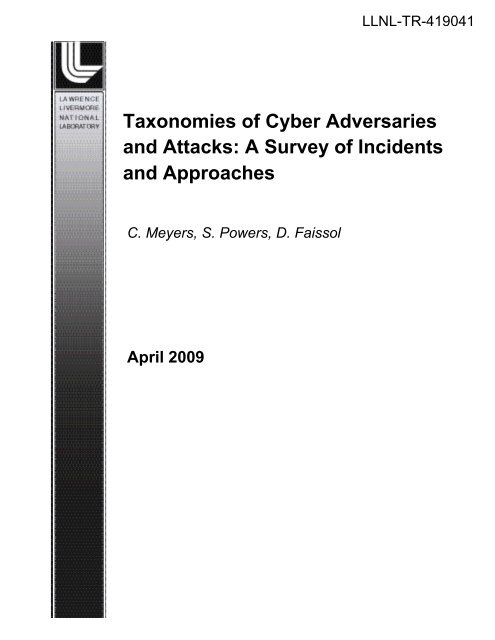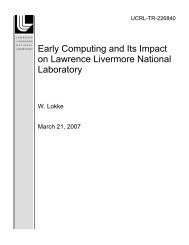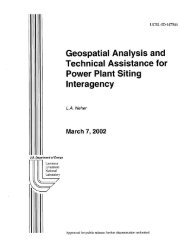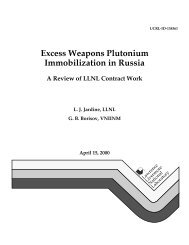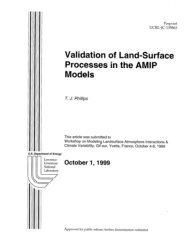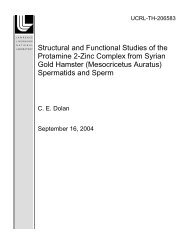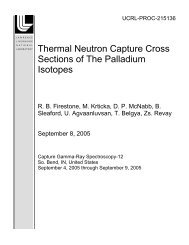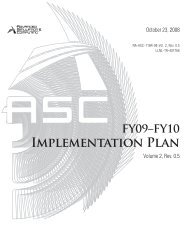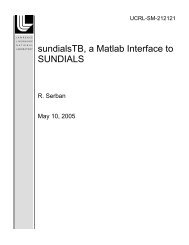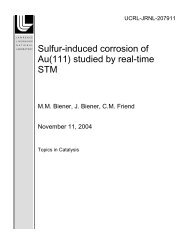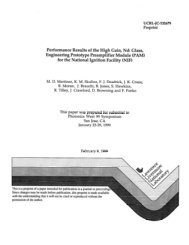Taxonomies of Cyber Adversaries and Attacks - Site Index Page ...
Taxonomies of Cyber Adversaries and Attacks - Site Index Page ...
Taxonomies of Cyber Adversaries and Attacks - Site Index Page ...
Create successful ePaper yourself
Turn your PDF publications into a flip-book with our unique Google optimized e-Paper software.
C. Meyers, S. Powers, D. Faissol<br />
April 2009<br />
August 2007<br />
LLNL-TR-419041<br />
<strong>Taxonomies</strong> <strong>of</strong> <strong>Cyber</strong> <strong>Adversaries</strong><br />
<strong>and</strong> <strong>Attacks</strong>: A Survey <strong>of</strong> Incidents<br />
<strong>and</strong> Approaches
This document was prepared as an account <strong>of</strong> work sponsored by an agency <strong>of</strong> the United States<br />
government. Neither the United States government nor Lawrence Livermore National Security, LLC, nor<br />
any <strong>of</strong> their employees makes any warranty, expressed or implied, or assumes any legal liability or<br />
responsibility for the accuracy, completeness, or usefulness <strong>of</strong> any information, apparatus, product, or<br />
process disclosed, or represents that its use would not infringe privately owned rights. Reference herein to<br />
any specific commercial product, process, or service by trade name, trademark, manufacturer, or<br />
otherwise does not necessarily constitute or imply its endorsement, recommendation, or favoring by the<br />
United States government or Lawrence Livermore National Security, LLC. The views <strong>and</strong> opinions <strong>of</strong><br />
authors expressed herein do not necessarily state or reflect those <strong>of</strong> the United States government or<br />
Lawrence Livermore National Security, LLC, <strong>and</strong> shall not be used for advertising or product<br />
endorsement purposes.<br />
This work performed under the auspices <strong>of</strong> the U.S. Department <strong>of</strong> Energy by Lawrence Livermore<br />
National Laboratory under Contract DE-AC52-07NA27344.<br />
2
<strong>Taxonomies</strong> <strong>of</strong> <strong>Cyber</strong> <strong>Adversaries</strong> <strong>and</strong> <strong>Attacks</strong><br />
A Survey <strong>of</strong> Incidents <strong>and</strong> Approaches<br />
Abstract<br />
In this paper we construct taxonomies <strong>of</strong> cyber adversaries <strong>and</strong> methods <strong>of</strong> attack, drawing from a survey<br />
<strong>of</strong> the literature in the area <strong>of</strong> cyber crime. We begin by addressing the scope <strong>of</strong> cyber crime, noting its<br />
prevalence <strong>and</strong> effects on the US economy. We then survey the literature on cyber adversaries,<br />
presenting a taxonomy <strong>of</strong> the different types <strong>of</strong> adversaries <strong>and</strong> their corresponding methods, motivations,<br />
maliciousness, <strong>and</strong> skill levels. Subsequently we survey the literature on cyber attacks, giving a<br />
taxonomy <strong>of</strong> the different classes <strong>of</strong> attacks, subtypes, <strong>and</strong> threat descriptions. The goal <strong>of</strong> this paper is to<br />
inform future studies <strong>of</strong> cyber security on the shape <strong>and</strong> characteristics <strong>of</strong> the risk space <strong>and</strong> its associated<br />
adversaries.<br />
I. <strong>Cyber</strong> Crime<br />
<strong>Cyber</strong> defense is a vast <strong>and</strong> growing problem in national security. According to the FBI, the annual loss<br />
due to cyber crime was estimated at $67.2 billion for US organizations in 2005 (GAO, 2007). As<br />
opposed to traditional crime, cyber crime has the advantages <strong>of</strong> being able to target a vast number <strong>of</strong><br />
victims, it can be executed quickly, <strong>and</strong> it is unhindered by the attacker‟s physical location or proximity.<br />
In a survey <strong>of</strong> more than 8,000 businesses conducted by the US Department <strong>of</strong> Justice in 2005<br />
(see Rantala, 2008), 67% <strong>of</strong> the companies reported detecting at least one cybercrime in the past year.<br />
Contributing to this number were the nearly 60% <strong>of</strong> respondents who discovered one or more types <strong>of</strong><br />
cyber attack, 11% who identified cyber theft, <strong>and</strong> 24% who experienced other security incidents. The<br />
monetary losses for these businesses exceeded $867 million, <strong>and</strong> system downtime totaled 323,900 hours.<br />
Two-thirds <strong>of</strong> all such incidents were targeted against companies in the US critical infrastructure, <strong>of</strong><br />
which telecommunications firms suffered the greatest number <strong>of</strong> attacks (Rantala, 2008). These statistics<br />
conclusively demonstrate that cyber crime is a major problem for US businesses.<br />
On an individual level, cyber crime can also be extremely destructive. The FBI-sponsored<br />
Internet Crime Complaint Center logs complaints <strong>of</strong> internet fraud <strong>and</strong> forwards relevant claims to<br />
federal, state, <strong>and</strong> local law enforcement agencies. According to the Internet Crime Report (ICCC, 2008),<br />
this website received 275,284 separate complaint submissions in 2008, a 33% increase over complaints in<br />
3
the year 2007. The total dollar amount <strong>of</strong> these individual cases <strong>of</strong> fraud came to $264.6 million, or $931<br />
per complainant referred to law enforcement. The top three categories <strong>of</strong> fraud complaints were nondelivered<br />
merch<strong>and</strong>ise, internet auction fraud, <strong>and</strong> credit/debit card fraud. Email <strong>and</strong> webpages were the<br />
two primary mechanisms by which the fraud took place (ICCC, 2008).<br />
Numerous products have been created to help mitigate the effects <strong>of</strong> cyber crime, from anti-virus<br />
<strong>and</strong> anti-spyware programs to intrusion detection/prevention systems to advanced application-level<br />
firewalls (Richardson, 2008). The US government also sponsors a number <strong>of</strong> organizations that manage<br />
<strong>and</strong> respond to cyber threats, most notably the United States Computer Emergency Readiness Team, or<br />
US-CERT. Among the publications <strong>of</strong> US-CERT are monthly activity summaries <strong>of</strong> general threat<br />
activities, as well as quarterly trends <strong>and</strong> analysis reports detailing the evolution <strong>of</strong> threats over the course<br />
<strong>of</strong> several months (US-CERT, 2008).<br />
Given that cyber security is such a vast problem, it is essential in constructing a defensive<br />
architecture to know who the cyber adversaries are <strong>and</strong> what kinds <strong>of</strong> threats they are likely to attempt.<br />
This paper surveys the literature on cyber adversaries <strong>and</strong> attacks, presenting taxonomies <strong>of</strong> the different<br />
types <strong>of</strong> players <strong>and</strong> attack methods. In each case, we describe the relevant studies that have been<br />
performed as well as providing a detailed explanation <strong>of</strong> each <strong>of</strong> the entries in the taxonomy. Where<br />
possible, we give specific examples <strong>of</strong> the particular adversaries <strong>and</strong> attack types featured. Our goal is for<br />
this work to be used in future studies <strong>of</strong> cyber security.<br />
II. Taxonomy <strong>of</strong> <strong>Cyber</strong> <strong>Adversaries</strong><br />
A. History <strong>and</strong> Motivation<br />
The study <strong>of</strong> cyber adversaries was initiated in the early 1980‟s, when personal computers began to come<br />
into the mainstream <strong>and</strong> the term „hacker‟ entered the lexicon as a person skilled at programming <strong>and</strong><br />
manipulating operating systems. The early hackers were products <strong>of</strong> MIT <strong>and</strong> other top technical schools,<br />
who enjoyed programming <strong>and</strong> stretching the abilities <strong>of</strong> computers (Raymond, 2003; Walleij, 1998).<br />
The use <strong>of</strong> the word „hacker‟ to describe an individual engaging in malicious activity emerged several<br />
years later, after the widely publicized arrest <strong>of</strong> six teenagers known as the „414 gang,‟ who notably broke<br />
into 60 computer systems, including those <strong>of</strong> the Los Alamos National Laboratory (Murphy et al., 1983).<br />
Within the computer science community today, there are many who argue against the perceived<br />
misappropriation <strong>of</strong> the term „hacker,‟ preferring the term „cracker‟ to describe individuals engaging in<br />
malicious behavior <strong>and</strong> breaking into security systems (Lawson, 2001).<br />
Notwithst<strong>and</strong>ing the debate on nomenclature, by the mid-1980‟s there was a growing interest on the<br />
part <strong>of</strong> law enforcement in underst<strong>and</strong>ing who these cyber adversaries were <strong>and</strong> how to stop them<br />
(Sterling, 1994). The Comprehensive Crime Control Act <strong>of</strong> 1984 was the first attempt at addressing<br />
computer fraud, <strong>and</strong> the Computer Fraud <strong>and</strong> Abuse act <strong>of</strong> 1986 specifically defined breaking into<br />
computer systems as a crime (Eltringham, 2007). Pr<strong>of</strong>iling <strong>of</strong> cyber adversaries suddenly became<br />
important as a method <strong>of</strong> identifying these criminals <strong>and</strong> determining their motivations (Smith & Rupp,<br />
2002). We now discuss several <strong>of</strong> the most prominent studies in this area, which have greatly influenced<br />
our own work.<br />
4
L<strong>and</strong>reth (1985)<br />
One <strong>of</strong> the first attempts to define <strong>and</strong> describe the community <strong>of</strong> cyber adversaries was done by<br />
L<strong>and</strong>reth, an accomplished hacker himself (Gorman, 1986; Chapa & Craig, 1996). He proposed five<br />
categories <strong>of</strong> individuals within the hacking community:<br />
novices<br />
students<br />
tourists<br />
crashers<br />
thieves<br />
The novices consisted <strong>of</strong> entry-level hackers, usually around ages 12-14, who engaged in petty mischief<br />
making. Individuals in this class got bored quickly <strong>and</strong> easily made mistakes. The students followed in<br />
the tradition <strong>of</strong> 1970‟s students at MIT, engaging in hacking primarily for the intellectual challenge, with<br />
minimal criminal motivation <strong>and</strong> the desire to simply gather information about infiltrated systems. The<br />
next category, tourists, engaged in hacking primarily for the thrill <strong>of</strong> being there. They felt the need to<br />
test themselves <strong>and</strong> experience a sense <strong>of</strong> adventure. By contrast, crashers engaged in destructive<br />
behavior <strong>and</strong> sought to intentionally damage information <strong>and</strong> systems. These adversaries enjoyed taking<br />
credit for their attacks <strong>and</strong> stroking their egos. Rarest <strong>of</strong> all the classes were the thieves: these individuals<br />
were true criminals, <strong>and</strong> usually pr<strong>of</strong>ited <strong>of</strong>f <strong>of</strong> their malicious activities. They were also the most<br />
dangerous <strong>and</strong> sophisticated <strong>of</strong> hackers, as they were <strong>of</strong>ten technically sophisticated pr<strong>of</strong>essionals who<br />
researched their targets thoroughly in advance.<br />
Hollinger (1988)<br />
A criminologist at the University <strong>of</strong> Florida, Hollinger interviewed several students who were convicted<br />
<strong>of</strong> gaining unauthorized access to the university‟s account management system <strong>and</strong> modifying or<br />
damaging a number <strong>of</strong> files. From these interviews, he determined that the hackers followed a<br />
progression from less skilled to more technically elite crimes. He proposed that these individuals fit into<br />
three categories:<br />
pirates<br />
browsers<br />
crackers<br />
The pirates were the least technically sophisticated adversaries, primarily confining their activities to<br />
copyright infringements <strong>and</strong> the distribution <strong>of</strong> illegally copied s<strong>of</strong>tware. This category also contained<br />
the greatest number <strong>of</strong> <strong>of</strong>fenders. In addition to piracy, the browsers gained occasional unauthorized<br />
access to the computer accounts <strong>of</strong> others <strong>and</strong> browsed through private files. Individuals in this class<br />
possessed a moderate technical ability but were not necessarily malicious. The crackers were the most<br />
serious abusers, engaging in repeated modification or sabotage <strong>of</strong> others‟ files <strong>and</strong> programs. They were<br />
both the most technically sophisticated hackers <strong>and</strong> also the most malicious, seeking to crash entire<br />
computer systems.<br />
5
Chantler (1996)<br />
The goal <strong>of</strong> Chantler‟s work was to perform a large-scale ethnographic study <strong>of</strong> hackers. He argued that<br />
hacking behavior could be categorized along several different attributes, including knowledge,<br />
motivation, prowess, <strong>and</strong> length <strong>of</strong> time involved. His study was primarily qualitative in nature <strong>and</strong> drew<br />
upon surveys <strong>and</strong> interviews with 164 known hackers. Based on this research, he proposed three<br />
categories <strong>of</strong> hackers:<br />
losers <strong>and</strong> lamers<br />
neophytes<br />
elites<br />
The losers <strong>and</strong> lamers demonstrated little intellectual ability, <strong>and</strong> were primarily motivated by greed <strong>and</strong><br />
vengeance. Individuals in this group constituted 10% <strong>of</strong> the hacker population. Neophytes, the next most<br />
sophisticated group, were learners <strong>and</strong> followers <strong>and</strong> tended to pursue where the elites had been. They<br />
were also the largest component <strong>of</strong> the sample, at around 60%. The elites displayed a high level <strong>of</strong><br />
technical ability <strong>and</strong> were motivated by achievement, excitement, <strong>and</strong> challenge. Members <strong>of</strong> this class<br />
constituted the remaining 30% <strong>of</strong> the population.<br />
Rogers (1999, 2001, 2006)<br />
The most comprehensive study <strong>of</strong> cyber adversaries <strong>and</strong> their motivations is due to Rogers, who over the<br />
past decade has developed <strong>and</strong> refined several taxonomies <strong>of</strong> hackers, in addition to receiving coverage in<br />
the popular press (Glave, 1999). His earliest work (1999) was done as a companion to his PhD thesis<br />
(2001), which examined demographic <strong>and</strong> social characteristics associated with a sample <strong>of</strong> 66 cyber<br />
adversaries. In particular, he discovered that these cyber adversaries were:<br />
predominantly male (81.8% male; 18.2% female)<br />
Caucasian (72.7% Caucasian; 10.6% Asian; 10.6% not stated; 6.1% other races)<br />
single (56.1% single; 18.2% married; 13.6% divorced; 11.1% other or unknown)<br />
high-school educated (47.0% high school; 18.2% 9 th grade; 4.5% college; 30.3% other or<br />
unknown)<br />
He also found that hackers displayed high levels <strong>of</strong> moral disengagement (convincing oneself that ethical<br />
st<strong>and</strong>ards do not apply in certain contexts), as well as differential association (learning their behavior<br />
through the examples <strong>of</strong> others). A follow-on work discussed the applicability <strong>of</strong> psychological theories<br />
for explaining this behavior (Rogers, 2000).<br />
The taxonomy <strong>of</strong> cyber adversaries that we propose at the end <strong>of</strong> this section is heavily drawn<br />
from the adversary taxonomies proposed by Rogers (1999; 2006); a more thorough discussion <strong>of</strong> this<br />
work ensues at that point.<br />
Subgroup Studies<br />
Most <strong>of</strong> the other studies concerning cyber adversaries <strong>and</strong> their behavior have focused on a specific<br />
subgroup <strong>of</strong> adversaries, centered around their method <strong>of</strong> attack. Gordon (2000, 2006) has examined the<br />
subclass <strong>of</strong> virus writers, who compose the scripts that are used by themselves <strong>and</strong> others to infiltrate<br />
computer systems. She suggests that virus writers are primarily composed <strong>of</strong> four groups (adolescents;<br />
6
college students; adults; ex-virus writers), <strong>of</strong> which only the adult group was shown to be ethically<br />
abnormal (possessing a lower than average level <strong>of</strong> ethical maturity). The first two groups were ethically<br />
average but showed little concern or responsibility for the results <strong>of</strong> their actions, <strong>and</strong> the last group cited<br />
a variety <strong>of</strong> reasons for leaving the “craft.”<br />
Shaw, Ruby, <strong>and</strong> Post (1998) study a different subclass <strong>of</strong> adversaries, specifically those involved<br />
with insider threats. They provide a suite <strong>of</strong> psychological pr<strong>of</strong>iles associated with such insiders, as well<br />
as citing a number <strong>of</strong> specific case studies. They suggest that the key factors associated with a person<br />
becoming an insider adversary are: introversion, social <strong>and</strong> personal frustration, computer dependency,<br />
ethical “flexibility,” reduced loyalty, entitlement, <strong>and</strong> lack <strong>of</strong> empathy. These findings are elaborated <strong>and</strong><br />
exp<strong>and</strong>ed upon in works by Post (1998) <strong>and</strong> Steele & Wargo (2007).<br />
Other work has examined the characteristics <strong>of</strong> adversaries who write computer worms (Weaver<br />
et al., 2003), web spammers (Jennings, 2007), political „hacktivists‟ (Denning, 2001), <strong>and</strong> the subset <strong>of</strong><br />
hackers who engage in identity theft (Fötinger & Ziegler, 2004). While it is possible to probe with greater<br />
depth in narrowly focused studies such as these, the goal <strong>of</strong> our work is to provide a broad, macro-level<br />
description <strong>of</strong> cyber adversary behavior <strong>and</strong> motivations.<br />
B. Proposed Adversary Taxonomy<br />
Our taxonomy <strong>of</strong> cyber adversaries is featured in Table 1. We draw heavily from the work <strong>of</strong> Rogers<br />
(2000, 2006), as well as several <strong>of</strong> the other studies mentioned in this section. For each <strong>of</strong> the adversary<br />
types, we list the corresponding skill level, maliciousness, motivation, <strong>and</strong> method. In what follows, we<br />
give descriptions <strong>of</strong> each <strong>of</strong> the adversary classes, in terms <strong>of</strong> increasing levels <strong>of</strong> skill <strong>and</strong> sophistication.<br />
script kiddies, newbies, novices<br />
This is the least sophisticated category <strong>of</strong> adversaries, comprised <strong>of</strong> individuals with limited programming<br />
skills. They are new to hacking <strong>and</strong> rely on pre-written scripts known as „toolkits‟ in their exploits;<br />
examples <strong>of</strong> these include NeoSploit, WebAttacker, <strong>and</strong> IcePack (Westervelt, 2007) . The primary<br />
motivation <strong>of</strong> these adversaries is boredom <strong>and</strong> thrill-seeking; they are <strong>of</strong>ten young <strong>and</strong> eager for<br />
acceptance from the hacker subculture. Though they are attracted to deviant behavior, their overall<br />
maliciousness level tends to be low, because <strong>of</strong> their limited skills. With the increasing sophistication <strong>of</strong><br />
the available toolkits, their ability to pull <strong>of</strong>f larger-scale attacks is on the rise, as in the case <strong>of</strong> the denial<strong>of</strong>-service<br />
attacks perpetuated by „Mafia Boy‟ in Canada (Rogers, 2006).<br />
hacktivists, political activists<br />
These adversaries are different than the other classes in that they are motivated by a political cause rather<br />
than a form <strong>of</strong> personal gain. Their attacks consist primarily <strong>of</strong> denial <strong>of</strong> service <strong>and</strong> defacement attacks<br />
against the sites <strong>of</strong> rival organizations, though they have also been known to employ worms <strong>and</strong> viruses<br />
(Denning, 2001). Their maliciousness is highly focused against the targeted organizations, though it can<br />
still have broad-reaching consequences. Some examples <strong>of</strong> hacktivism include the „virtual sit-ins‟<br />
perpetuated by Electronic Disturbance Theater against the Pentagon <strong>and</strong> other agencies, in protest <strong>of</strong><br />
perceived civil rights violations; email bombs used by the Internet Black Tigers throughout Sri Lanka to<br />
gain publicity for the Tamil Tigers; <strong>and</strong> worm propagation by WANK (Worms Against Nuclear Killers)<br />
on computers in NASA‟s Goddard Space Flight center, protesting an upcoming launch (Denning, 2001).<br />
7
Adversary Class Skills Maliciousness Motivation Method<br />
script kiddies, newbies,<br />
novices<br />
hacktivists, political<br />
activists<br />
cyber punks, crashers,<br />
thugs<br />
insiders, user<br />
malcontents<br />
very low low<br />
low moderate<br />
low moderate<br />
moderate high<br />
coders, writers high moderate<br />
white hat hackers,<br />
old guard, sneakers<br />
black hat hackers,<br />
pr<strong>of</strong>essionals, elite<br />
high very low<br />
very high very high<br />
cyber terrorists very high very high<br />
boredom, thrill<br />
seeking<br />
promotion <strong>of</strong> a<br />
political cause<br />
prestige, personal<br />
gain, thrill seeking<br />
disgruntlement,<br />
personal gain,<br />
revenge<br />
power, prestige,<br />
revenge, respect<br />
intellectual gain,<br />
ethics, respect<br />
personal gain,<br />
greed, revenge<br />
ideology, politics,<br />
espionage<br />
Table 1. A Taxonomy <strong>of</strong> <strong>Cyber</strong> <strong>Adversaries</strong><br />
download <strong>and</strong> run already-written hacking scripts<br />
known as ‟toolkits‟.<br />
engage in denial <strong>of</strong> service attacks or defacement<br />
<strong>of</strong> rival cause sites<br />
write own scripts, engage in malicious acts, brag<br />
about exploits<br />
uses insider privileges to attack current or former<br />
employers<br />
write scripts <strong>and</strong> automated tools used by newbies,<br />
serve as mentor<br />
non-malicious hacking to help others <strong>and</strong> test new<br />
programming<br />
sophisticated attacks by criminals/thieves; may be<br />
„guns for hire‟ or involved in organized crime<br />
state-sponsored, well-funded cyber attacks<br />
against enemy nations
cyber punks, crashers, thugs<br />
<strong>Adversaries</strong> in this class have similar motivations but greater skills than those in the novice category.<br />
They are capable <strong>of</strong> writing their own (limited) scripts <strong>and</strong> engaging in malicious acts such as spamming,<br />
defacing, <strong>and</strong> identity theft. These hackers seek attention <strong>and</strong> prestige <strong>and</strong> are most likely to be featured<br />
in the media, <strong>of</strong>ten because they pick high-pr<strong>of</strong>ile targets <strong>and</strong> come under the notice <strong>of</strong> authorities<br />
(Rogers, 2006). Occasionally such adversaries will go on to become internet security consultants, as in<br />
the case <strong>of</strong> Kevin Mitnick, who combined his hacking skills with social engineering to gain access to<br />
restricted systems (Mitnick, 2002; Rogers, 2006).<br />
insiders, user malcontents<br />
This group <strong>of</strong> adversaries represents arguably the greatest risk to companies, <strong>and</strong> yet is <strong>of</strong>ten the least<br />
publicized (Rogers, 2006; Gelles et al., 2008). Insiders are most frequently motivated by revenge, usually<br />
in response to a negative work-related event; this frustration leads them to deliberately attack their own<br />
company (Kowalski et al., 2008). The scope <strong>of</strong> insider damage can be extremely large, as these<br />
individuals are <strong>of</strong>ten very familiar with the systems that they are attacking <strong>and</strong> <strong>of</strong>ten hold elevated access<br />
privileges. Insiders <strong>of</strong>ten seek to sabotage systems, as in the case <strong>of</strong> Michael Lauffenberger, who planted<br />
a logic bomb to delete data in a system that he designed <strong>and</strong> envisioned subsequently coming to „rescue‟<br />
his company (Shaw et al., 1998).<br />
coders, writers<br />
<strong>Adversaries</strong> in this category are primarily involved in writing the codes <strong>and</strong> exploits that are used by<br />
others, especially those in the novice category. Their motivation is power <strong>and</strong> prestige: they see<br />
themselves as the mentors to the younger hackers <strong>and</strong> like feeling important (Rogers, 2006). There is a<br />
continuum <strong>of</strong> ability within individuals in the category, <strong>and</strong> it has been suggested that many such writers<br />
eventually „age out‟ <strong>of</strong> this behavior (Gordon, 2006). In general, such writers can be quite dangerous, as<br />
their s<strong>of</strong>tware can be widely distributed <strong>and</strong> acquire a life <strong>of</strong> its own.<br />
white hat hackers, old guard, sneakers<br />
Individuals in this category consider themselves „purists‟ <strong>and</strong> ascribe to the flavor <strong>of</strong> hacking initially<br />
popularized at MIT in the early days <strong>of</strong> computers. They are not malicious hackers <strong>and</strong> do not wish to<br />
cause damage, though they <strong>of</strong>ten show a lack <strong>of</strong> regard for personal privacy (Rogers, 2006). White hat<br />
hackers are primarily motivated by the intellectual challenge <strong>of</strong> testing security systems <strong>and</strong> creating new<br />
programming. They are <strong>of</strong>ten hired as security analysts, paid to test a company‟s defenses by trying to<br />
break into their system <strong>and</strong> assessing its response (Barber, 2001). The National Security Agency even<br />
<strong>of</strong>fers certification in such „ethical hacking‟ activities (Taylor et al., 2006). Although these individuals<br />
probably should not be considered “adversaries,” we include them in our treatment for the sake <strong>of</strong><br />
completeness.<br />
black hat hackers, pr<strong>of</strong>essionals, elite<br />
The adversaries in this category are pr<strong>of</strong>essional criminals, who use their technical skills in pursuance <strong>of</strong><br />
their criminal activities. Similar to criminals outside the cyber domain, they are motivated by money <strong>and</strong><br />
greed. Rather than seeking fame, they prefer to lay low <strong>and</strong> evade authorities (Rogers, 2006). These<br />
hackers are both rare <strong>and</strong> very dangerous, as they have strong technical skills <strong>and</strong> are <strong>of</strong>ten able to support<br />
themselves through their criminal exploits. Such adversaries are <strong>of</strong>ten employed by organized crime, <strong>and</strong><br />
9
can be described as „guns for hire‟. Although this is one <strong>of</strong> the most dangerous types <strong>of</strong> cyber adversaries,<br />
it is also the one about which the least is known (Rogers, 2006).<br />
cyber terrorists<br />
The most dangerous <strong>and</strong> skilled <strong>of</strong> all cyber adversary classes, cyber terrorists engage in state-sponsored<br />
information technology warfare. Their job is to conduct attacks that destabilize, disrupt, <strong>and</strong> destroy the<br />
cyber assets <strong>and</strong> data <strong>of</strong> an enemy nation or government organization (Rogers, 2006). <strong>Attacks</strong> by cyber<br />
terrorists are typically well-funded <strong>and</strong> highly secretive; individuals engaging in such activities have<br />
extremely high skills <strong>and</strong> are motivated by ideology. One <strong>of</strong> the best known examples <strong>of</strong> such terrorism<br />
occurred in Estonia in 2007, following the removal <strong>of</strong> a Russian World War II monument; a massive<br />
denial <strong>of</strong> service attack crippled the websites <strong>of</strong> Parliament, several national newspapers, <strong>and</strong> the central<br />
bank (L<strong>and</strong>ler & Mark<strong>of</strong>f, 2007). A similarly crippling DDoS attack preceded the conflict between<br />
Russia <strong>and</strong> the Republic <strong>of</strong> Georgia in 2008 (Mark<strong>of</strong>f, 2008). Such attacks are hard to prosecute, which<br />
makes them even more dangerous, <strong>and</strong> guarding against these attacks has become a top national priority.<br />
In Figure 1 we give a two-dimensional circumplex representation <strong>of</strong> the cyber adversary types described<br />
in this paper. This is reproduced from the work <strong>of</strong> Rogers (2006), with some small modifications.<br />
Motivation <strong>of</strong> the adversary types is represented along the circumference <strong>of</strong> the circle, <strong>and</strong> the<br />
sophistication level is measured along the radii. For example, the „insider‟ label indicates that insiders are<br />
primarily motivated by revenge, though finance is a factor, <strong>and</strong> they have a solid technical ability.<br />
Figure 1. A circumplex depiction <strong>of</strong> the adversary types in this paper (following Rogers, 2006).<br />
10
III. Taxonomy <strong>of</strong> <strong>Cyber</strong> <strong>Attacks</strong><br />
A. History <strong>and</strong> Motivation<br />
The formal study <strong>of</strong> cyber security began in the mid-1970‟s, when computers first became prominent in<br />
the government <strong>and</strong> universities. The earliest studies were primarily mechanical in nature <strong>and</strong> focused on<br />
the formal verification <strong>of</strong> the security <strong>of</strong> computer operating systems. As early as 1975, researchers at<br />
UCLA attempted to design, implement, <strong>and</strong> verify a security kernel for UNIX (Popek & Kline, 1975).<br />
Other work sponsored by the Air Force at MITRE <strong>and</strong> Case Western University focused on the<br />
construction <strong>of</strong> prototype security kernels <strong>and</strong> formal models <strong>of</strong> computer security (Walter et al., 1975;<br />
Bell & La Padula, 1976). L<strong>and</strong>wehr (1981) reviews the state <strong>of</strong> cyber security in the 1970‟s <strong>and</strong> the<br />
progress <strong>of</strong> these <strong>and</strong> other early efforts.<br />
Most <strong>of</strong> this early work in cyber security did not explicitly consider the different types <strong>of</strong> attacks<br />
that might be perpetuated. The first studies <strong>of</strong> cyber attacks in particular arose in the early to mid-1980‟s,<br />
around the same time that cyber adversaries first entered the public eye. Stoll (1986) describes the<br />
methods a German hacker used to break into computer systems at Lawrence Berkeley National Lab, <strong>and</strong><br />
how researchers there used the hacker‟s activities to track him. The Computer Emergency Response<br />
Team (CERT) was founded by DARPA in 1988, after a high-pr<strong>of</strong>ile crippling <strong>of</strong> the internet via the<br />
Morris worm (Scherlis, 1988; Kehoe, 1992).<br />
One <strong>of</strong> the major issues in studying cyber attacks is that the notion <strong>of</strong> an “attack” itself is quite<br />
broad: it can encompass attack vectors, operating systems, hardware <strong>and</strong> s<strong>of</strong>tware targets, access<br />
schemes, attacker objectives, specific implementation <strong>and</strong> design vulnerabilities, <strong>and</strong> the attack payload<br />
(Howard, 1997; Hansman & Hunt, 2005). It is practically infeasible to encompass all <strong>of</strong> these aspects in a<br />
single taxonomy, as the associated length would be overwhelming. In the next sections, we review some<br />
<strong>of</strong> the literature that attempts to tackle pieces <strong>of</strong> this larger problem, followed by our own attack<br />
taxonomy. It should be noted that in our taxonomy, we will focus primarily on attacks in terms <strong>of</strong> their<br />
associated attack vectors—specifically, the general class <strong>of</strong> methods <strong>and</strong> exploits that the attack uses.<br />
This high-level treatment <strong>of</strong> the attack space allows for a much more tractable representation.<br />
L<strong>and</strong>wehr et al. (1994)<br />
Drawing from a number <strong>of</strong> widely documented cyber security incidents in the 1970‟s <strong>and</strong> 1980‟s,<br />
L<strong>and</strong>wehr et al. presented a taxonomy <strong>of</strong> computer security flaws. Their taxonomy consisted <strong>of</strong> three<br />
major components, according to the nature <strong>of</strong> when <strong>and</strong> where a given flaw was introduced. These were:<br />
flaws by genesis (how a flaw arises: maliciously, non-maliciously, or inadvertently)<br />
flaws by time <strong>of</strong> introduction (when a flaw is introduced: development, operations, or<br />
maintenance)<br />
flaws by location (where a flaw is located: s<strong>of</strong>tware or hardware)<br />
Each <strong>of</strong> these three major components contained several sub-components; for instance, malicious flaws<br />
were broken down into trojan horses, viruses, trapdoors, <strong>and</strong> logic/time bombs. Likewise, the category <strong>of</strong><br />
s<strong>of</strong>tware flaws was decomposed by operating system, support, <strong>and</strong> application. The most novel<br />
contribution <strong>of</strong> this work consisted <strong>of</strong> the authors‟ detailed classification <strong>of</strong> 50 real security flaws into this<br />
framework. This was accompanied by a description <strong>of</strong> each <strong>of</strong> the flaws <strong>and</strong> their justification for the<br />
categorization <strong>of</strong> each flaw within the taxonomy.<br />
11
Howard (1997); Howard <strong>and</strong> Longstaff (1998)<br />
One <strong>of</strong> the most comprehensive studies <strong>of</strong> computer security incidents was performed by Howard, as the<br />
basis for his Ph.D. thesis at Carnegie Mellon University. In this work <strong>and</strong> a companion paper the<br />
following year, he executed a detailed analysis <strong>of</strong> data collected by CERT/CC consisting <strong>of</strong> over 4,500<br />
security incidents between 1989 <strong>and</strong> 1995. Based on this data, he proposed a network <strong>and</strong> attack<br />
taxonomy for classifying <strong>and</strong> comparing such incidents. This taxonomy contained five primary<br />
components:<br />
attackers (hackers, spies, terrorists, corporate raiders, pr<strong>of</strong>essional criminals, v<strong>and</strong>als)<br />
tools (scripts, autonomous agents, toolkits, user comm<strong>and</strong>s, data tap)<br />
access (implementation/design vulnerabilities, authorized/unauthorized access, processes)<br />
results (corruption/disclosure <strong>of</strong> information, theft <strong>of</strong> service, denial <strong>of</strong> service)<br />
objectives (challenge, status, political gain, financial gain, damage)<br />
This taxonomy was very general <strong>and</strong> did not go into further detail. The objective was to provide a broad<br />
scheme within which different incidents could easily be placed. He proceeded to classify many <strong>of</strong> the<br />
security incidents into this framework, though at a (necessarily) lower fidelity than that <strong>of</strong> L<strong>and</strong>wehr et al<br />
(1994). The value <strong>of</strong> this work in particular lay in the large sample size, which made it possible to obtain<br />
a reasonable probabilistic description <strong>of</strong> the attack space.<br />
Hansman <strong>and</strong> Hunt (2005)<br />
Hansman <strong>and</strong> Hunt have provided the most thorough taxonomy <strong>of</strong> network <strong>and</strong> computer attacks to date.<br />
Their work extended that <strong>of</strong> earlier taxonomies by introducing multiple tiers <strong>of</strong> threats, with a greater<br />
exposition <strong>of</strong> levels <strong>and</strong> description within each category. Specifically, they classified attacks on four<br />
main dimensions:<br />
attack vectors (the main means by which the virus reaches the target)<br />
target(s) <strong>of</strong> the attack (hardware/s<strong>of</strong>tware/etc.)<br />
specific vulnerabilities <strong>and</strong> exploits that the attack uses (security flaws)<br />
payload <strong>of</strong> the attack (outcome <strong>and</strong> effects, possibly beyond the attack itself)<br />
These dimensions were decomposed based on the specificity <strong>of</strong> detail. Target categories consisted <strong>of</strong> six<br />
levels, ranging from generic descriptors (level 1: hardware versus s<strong>of</strong>tware) to very precise (level 6:<br />
specific versions <strong>of</strong> specific programs). Altogether this gave a very thorough picture <strong>of</strong> the attack space<br />
<strong>and</strong> available methods. They demonstrated how 15 well-known attacks could be classified on the<br />
dimensions <strong>of</strong> this taxonomy, from generic to specific levels <strong>of</strong> detail in each instance.<br />
Kjaerl<strong>and</strong> (2005, 2006)<br />
The work <strong>of</strong> Kjaerl<strong>and</strong> was notable for adding a quantitative component to the classification <strong>of</strong> network<br />
attacks. In particular, her work sought not only to classify the attacks, but also to determine which factors<br />
were most likely to co-occur in an attack. Her analysis was based on a sample <strong>of</strong> 2,755 reported incidents<br />
to CERT/CC, from the years 2000-2002. She classified the incidents based on four categories:<br />
source sectors (com, gov, edu, intl, user, unknown)<br />
method <strong>of</strong> operation (misuse <strong>of</strong> resources, user/root compromise, social engineering, virus,<br />
web compromise, trojan, worm, denial <strong>of</strong> service)<br />
12
impact (disrupt, distort, destruct, disclosure, unknown)<br />
target services (com, gov)<br />
After categorizing each <strong>of</strong> the reported incidents along these dimensions, she performed a smallest space<br />
analysis (SSA) to determine which <strong>of</strong> these factors were most likely to happen together. Her results<br />
showed, among other things, that “individual user” <strong>and</strong> “web compromise” were likely to occur together;<br />
conversely, “educational source” <strong>and</strong> “trojan” were not likely to co-occur. Although this analysis did not<br />
determine the causality <strong>of</strong> these incidents, this sort <strong>of</strong> correlative study is very useful in underst<strong>and</strong>ing the<br />
characteristics <strong>of</strong> the threat space.<br />
Other Work<br />
A larger body <strong>of</strong> literature can be found on cyber attacks as compared to that <strong>of</strong> cyber adversaries. With<br />
regards to taxonomies <strong>and</strong> classification, a number <strong>of</strong> studies focus on attacks in a specific area. These<br />
include Weaver at al. (2003), who gave a taxonomy <strong>of</strong> different kinds <strong>of</strong> computer worms, including<br />
propagation methods, payloads, <strong>and</strong> attacker motivation. Worms were also studied by Collins et al.<br />
(2006), within the context <strong>of</strong> opportunistic network exploits. Rutkowska (2006) gave a categorization <strong>of</strong><br />
different kinds <strong>of</strong> malware, <strong>and</strong> Lough (2001) gave a taxonomy <strong>of</strong> attacks with a particular focus on<br />
applications to wireless networks. Specht <strong>and</strong> Lee (2004) <strong>and</strong> Wood <strong>and</strong> Stankovic (2004) both gave<br />
classifications <strong>of</strong> distributed denial <strong>of</strong> service attacks, addressing both the different kinds <strong>of</strong> attack <strong>and</strong> the<br />
countermeasures that can be used against such attacks.<br />
There is also a great deal <strong>of</strong> work on mapping the prevalence <strong>of</strong> different cyber attacks (see the<br />
section on „<strong>Cyber</strong> Crime‟), including viruses (Bridwell, 2005) <strong>and</strong> malware websites (Keats, 2008).<br />
Lipson (2002) provides an excellent summary <strong>of</strong> cyber attacks over time, as reproduced in Figure 2.<br />
Figure 2. Sophistication <strong>of</strong> <strong>Cyber</strong> <strong>Attacks</strong> <strong>and</strong> Attackers over Time, from Lipson (2002)<br />
13
B. Proposed Attack Taxonomy<br />
Our taxonomy <strong>of</strong> cyber attacks is featured in Table 2. A description <strong>of</strong> the attack classes is given as well<br />
as a listing <strong>of</strong> the different subtypes <strong>of</strong> each attack vector. This taxonomy is primarily inspired by the<br />
work <strong>of</strong> Hansman <strong>and</strong> Hunt (2005), though it draws from the other references mentioned in this section as<br />
well. In what follows, we give a portrayal <strong>of</strong> each <strong>of</strong> the featured attack classes. We note that many<br />
recent incidents have employed more than one <strong>of</strong> these attack methods, so they should not necessarily be<br />
viewed as mutually incompatible alternatives.<br />
viruses<br />
A computer virus is a program that can copy itself <strong>and</strong> infect system files without knowledge <strong>of</strong> the user.<br />
Viruses are transferred when their host is connected with the target system, either via a computer network,<br />
the internet, or a form <strong>of</strong> removable media. The spread <strong>of</strong> viruses is dependent on user interaction, in<br />
particular in the execution <strong>of</strong> the corresponding virus code; for this reason many viruses are attached to<br />
legitimate program executables. The term „computer virus‟ was first used in 1983 by Frederick Cohen,<br />
who likened the spread <strong>of</strong> the program to a biological system (Highl<strong>and</strong>, 1997). Possibly the most<br />
destructive virus to date is the ILOVEYOU virus, a visual basic scripting virus that originated in the<br />
Philippines <strong>and</strong> caused 10 to 15 billion dollars <strong>of</strong> damage worldwide in the year 2000 (Jones, 2006).<br />
worms<br />
A computer worm is a self-replicating program that uses a host network to send copies <strong>of</strong> itself to other<br />
computers on the network. As opposed to viruses, worms do not need to attach themselves to existing<br />
programs <strong>and</strong> can be spread without any user interaction; moreover, they seek to infect the network<br />
infrastructure rather than individual files. Worms spread primarily by exploiting vulnerabilities in<br />
operating systems, most <strong>of</strong>ten striking unupdated systems after a major security patch. Commonly,<br />
worms install a „backdoor‟ on infected systems to allow remote control; using this, the Sobig worms were<br />
able to create a massive „botnet‟ <strong>of</strong> systems dedicated to sending spam (Levy, 2003). Worms can spread<br />
very quickly, as in the case <strong>of</strong> SQL Slammer, which shut down all <strong>of</strong> South Korea‟s online capacity for<br />
12 hours after its launch in 2003 (Jones, 2006).<br />
trojans<br />
Much like the mythical Trojan horse, trojan attacks function by concealing their malicious intent. They<br />
masquerade as a piece <strong>of</strong> s<strong>of</strong>tware that performs a desired function, while secretly executing malicious<br />
content. Users can are fooled into installing the trojan via one <strong>of</strong> many vectors, most <strong>of</strong>ten online<br />
downloads or email links. The most common types <strong>of</strong> trojans install a „backdoor‟ on infected systems to<br />
allow remote access, or engage in data destruction. As opposed to viruses <strong>and</strong> worms, trojans do not selfreplicate<br />
<strong>and</strong> rely entirely on the distribution <strong>of</strong> their host program to propagate. The earliest trojan horse<br />
dates back to 1975, when the computer game ANIMAL housed the subroutine PERVADE, which copied<br />
itself into every directory in which the user had access (Walker, 1996). More recently, in 2008 the<br />
Chinese password-collecting trojan Mocmex was found housed in digital photo frames (Soper, 2008).<br />
buffer overflows<br />
In programming, a buffer overflow occurs when a program writes more information into the buffer<br />
(temporary memory storage) than the space allocated to it in memory. During a buffer overflow attack,<br />
14
viruses<br />
Attack Class Subtypes Description<br />
file infectors, system/boot record infectors,<br />
macros<br />
worms mass mailing via botnets, network aware<br />
trojans remote access, data destruction<br />
buffer overflows stack-based overflows, heap-based overflows<br />
denial <strong>of</strong> service<br />
network attacks<br />
physical attacks<br />
password attacks/<br />
user compromise<br />
information gathering<br />
host (resource hogs, crashers), network (TCP,<br />
UDP, ICMP flooding), distributed<br />
spo<strong>of</strong>ing, web/email phishing, session hijacking,<br />
wireless WEP cracking, web application attacks<br />
basic, energy weapon (HERF gun, EMP/T<br />
bomb, LERF), Van Eck<br />
guessing (brute force, dictionary attacks),<br />
exploiting implementation<br />
packet sniffing, host mapping, security scanning,<br />
port scanning, OS fingerprinting<br />
Table 2. A Taxonomy <strong>of</strong> <strong>Cyber</strong> <strong>Attacks</strong><br />
self-replicating program that replicates through<br />
infected files; attached to an existing program<br />
self-replicating program that replicates through<br />
networks or email; no user interaction required<br />
program made to appear benign that serves a<br />
malicious purpose<br />
process that gains control or crashes another<br />
process via buffer overflowing<br />
attack that prevents legitimate users from accessing<br />
a host or network<br />
attack based on manipulating network protocols,<br />
against users or networks<br />
attacks based on damaging the physical<br />
components <strong>of</strong> a network or computer<br />
attacks aimed at acquiring a password or login<br />
credential<br />
attacks in which no damage is carried out, but<br />
information is gathered by attacker<br />
15
malicious users exploit this property by forcing a buffer overflow to overwrite local variables <strong>and</strong> alter<br />
program execution, forcing the process to execute malicious code introduced by the user. Such<br />
techniques are well-documented <strong>and</strong> most <strong>of</strong>ten used to gain control <strong>of</strong> host systems (Levy, 1996).<br />
This buffer overflow technique may be used as a method <strong>of</strong> enabling other attacks such as worms to be<br />
executed on a system. This method was used in both the Code Red <strong>and</strong> SQL Slammer worms, which<br />
exploited overflow vulnerabilities in Micros<strong>of</strong>t‟s Internet Information Services <strong>and</strong> SQL server<br />
respectively (Chen & Robert, 2004).<br />
denial <strong>of</strong> service<br />
A denial <strong>of</strong> service attack functions by making a computer network or resource inaccessible to legitimate<br />
users. Most <strong>of</strong>ten this is accomplished by “flooding” the target with data, so that it is overloaded with<br />
such requests. Common targets <strong>of</strong> these attacks include network routers (resulting in very slow network<br />
performance), DNS servers (resulting in an inability to access websites), <strong>and</strong> email accounts (resulting in<br />
a “mail bomb” deluge <strong>of</strong> spam). In a distributed denial <strong>of</strong> service attack, multiple systems combine to<br />
flood the b<strong>and</strong>width <strong>and</strong> resources <strong>of</strong> the target. The first widely publicized distributed attack occurred in<br />
2000, when numerous high-pr<strong>of</strong>ile websites (including Amazon.com, Yahoo, eBay, <strong>and</strong> CNN) were<br />
crippled for several hours (Garber, 2000). Such attacks can also have political overtones, as in the<br />
bombardment <strong>of</strong> Georgian government websites shortly preceding conflict with Russia (Mark<strong>of</strong>f, 2008).<br />
network attacks<br />
Within our taxonomy, a network attack is one in which network protocols are manipulated to exploit<br />
other users or systems. Examples <strong>of</strong> such attacks include IP spo<strong>of</strong>ing, in which the source IP address is<br />
falsified (Heberlein & Bishop, 1996); web/email phishing, in which a legitimate website or email is<br />
reproduced by a hacker (Emigh, 2005); session hijacking, in which the theft <strong>of</strong> a session cookie leads to<br />
exploitation <strong>of</strong> a valid computer session (Xia & Brustoloni, 2004); <strong>and</strong> cross-site scripting attacks, in<br />
which malicious code is injected into web applications (Di Lucca et al., 2004). These attacks are <strong>of</strong>ten<br />
used in conjunction with other attacks in the taxonomy, such as denial <strong>of</strong> service attacks. They can also<br />
be quite costly: an estimated $1.2 billion were lost in phishing attacks in the year 2003 (Emigh, 2005).<br />
physical attacks<br />
Some <strong>of</strong> the most frightening cyber attacks are physical in nature, such as those using electromagnetic<br />
radiation waves to disrupt or damage the electrical parts <strong>of</strong> a system or decode its signals. A high-energy<br />
radio frequency (HERF) gun blasts a high-power electromagnetic pulse capable <strong>of</strong> physically destroying a<br />
computer‟s motherboard <strong>and</strong> other components (Schwartau, 1996). Similar to this but even stronger is<br />
the electromagnetic pulse transformer (EMP/T) bomb, which can generate a thous<strong>and</strong> times the damage<br />
<strong>of</strong> HERF (Schwartau, 1996). Using a different mechanism, in a Van Eck attack the electromagnetic<br />
signals <strong>of</strong> a computer can be hacked to reveal the signal‟s data content, using equipment costing as little<br />
as $15 (Van Eck, 1985). The US government‟s TEMPEST component st<strong>and</strong>ards are designed to mitigate<br />
the risk <strong>of</strong> all these kinds <strong>of</strong> attacks, but they do not eliminate the problem (Russell & Gangemi, 1991).<br />
password attacks/user compromise<br />
Password attacks have the objective <strong>of</strong> gaining control <strong>of</strong> a particular system or user‟s account. There are<br />
three basic kinds <strong>of</strong> such attacks: guessing, based on knowledge <strong>of</strong> the user‟s personal details; dictionary<br />
attacks, which loop through a list <strong>of</strong> dictionary words <strong>and</strong> try to find a match; <strong>and</strong> brute force attacks,<br />
16
which loop through sequences <strong>of</strong> r<strong>and</strong>om characters. In a recent study <strong>of</strong> MySpace passwords, fully 4%<br />
consisted <strong>of</strong> dictionary words, <strong>and</strong> another 12% were a word followed by a single number (Evers, 2006).<br />
In a user compromise attack, the implementation <strong>of</strong> a system or program is exploited to gain access to<br />
sensitive information, such as credit card numbers. Hackers Ian Goldberg <strong>and</strong> David Wagner found such<br />
a problem in the r<strong>and</strong>om number generator used for secure sockets layer (SSL) transactions in Netscape<br />
1.1, allowing for easy decoding <strong>of</strong> encrypted communications (Goldberg & Wagner, 1996).<br />
info gathering/resource misuse<br />
The last category <strong>of</strong> attacks is not inherently malicious, but is <strong>of</strong>ten found as a precursor or component <strong>of</strong><br />
other attacks. These attacks are used to gather information about the target in an attempt to exploit its<br />
defenses <strong>and</strong> learn more about the system. A mapping exploit is used to gain information on the hosts in<br />
a network, including what programs are running <strong>and</strong> what operating system is used. Security scanning is<br />
similar, but involves testing the host for known vulnerabilities in the hardware or s<strong>of</strong>tware it is using. A<br />
packet sniffer is designed to intercept <strong>and</strong> log traffic on a network, which can potentially be decoded later<br />
(Hansman, 2003). Worms such as Sasser, Slammer, <strong>and</strong> Code Red also use scanning as a method <strong>of</strong><br />
determining vulnerable hosts to compromise (Kikuchi et al., 2008).<br />
IV. Conclusions<br />
We have surveyed the literature on cyber adversaries <strong>and</strong> attacks, providing a broad taxonomy <strong>of</strong> the<br />
relevant players <strong>and</strong> methods in each area. Whenever possible we have attempted to give illustrative<br />
examples for each <strong>of</strong> the particular adversary <strong>and</strong> attack types featured. It is our hope that this work can<br />
be used to inform further studies in adversary modeling <strong>and</strong> cyber security, particularly those that deal<br />
with adversarial threat response.<br />
A natural question for future research would be whether we can correlate the kinds <strong>of</strong> adversaries<br />
with the types <strong>of</strong> attacks they perform. In our survey we did not come across any such literature, which is<br />
probably due to a couple <strong>of</strong> reasons: first, such data would be necessarily difficult to come by, as it would<br />
likely be the result <strong>of</strong> criminal proceedings; <strong>and</strong> second, the majority <strong>of</strong> cyber attacks are very difficult to<br />
trace back to their originator. Still, as the body <strong>of</strong> research on cyber adversaries grows, it may be possible<br />
to do some sort <strong>of</strong> a probabilistic analysis in the future.<br />
Acknowledgements<br />
The authors wish to thank Tony Bartoletti for many helpful technical discussions <strong>and</strong> for suggesting<br />
we study this subject area. We would also like to thank Bill Hanley for overall guidance <strong>and</strong> support.<br />
17
References<br />
1. R. Barber. Hackers pr<strong>of</strong>iled: who are they <strong>and</strong> what are their motivations? Computer Fraud <strong>and</strong> Security,<br />
2(1):14-17, 2001.<br />
2. D. Bell <strong>and</strong> L. La Padula. Secure computer system: unified exposition <strong>and</strong> multics interpretation. Technical<br />
Report MTR-2997, MITRE Corporation, 1976. Accessed at http://csrc.nist.gov/publications/history/bell76.pdf.<br />
3. L. Bridwell. ICSA labs 10 th annual computer virus prevalence survey. Technical Report, ICSA Labs, 2005.<br />
Accessed at http://www.icsa.net/icsa/docs/html/library/whitepapers/VPS2004.pdf.<br />
4. N. Chantler. Pr<strong>of</strong>ile <strong>of</strong> a Computer Hacker. Infowar, 1996.<br />
5. S. Chapa <strong>and</strong> R. Craig. The anatomy <strong>of</strong> cracking. Online Publication, University <strong>of</strong> Texas, 1996. Accessed at<br />
http://www.actlab.utexas.edu/~aviva/compsec/cracker/crakhome.html.<br />
6. T. Chen <strong>and</strong> J. Robert. Worm epidemics in high-speed networks. Computer, 37(6):48-53, 2004. Accessed at<br />
http://ieeexplore.ieee.org/xpls/abs_all.jsp?arnumber=1306386.<br />
7. M. Collins, C. Gates, <strong>and</strong> G. Kataria. A model for opportunistic network exploits: the case <strong>of</strong> P2P worms. In<br />
Proceedings <strong>of</strong> the Fifth Workshop on the Economics <strong>of</strong> Information Security, Cambridge, Engl<strong>and</strong>, 2006.<br />
Accessed at http://weis2006.econinfosec.org/docs/30.pdf.<br />
8. D. Denning. Activism, hacktivism, <strong>and</strong> cyberterrorism: the internet as a tool for influencing foreign policy.<br />
Chapter 8 <strong>of</strong> Networks <strong>and</strong> Netwars: the Future <strong>of</strong> Terror, Crime, <strong>and</strong> Militancy, R<strong>and</strong> Monograph MR-1382,<br />
2001. Accessed at http://www.r<strong>and</strong>.org/pubs/monograph_reports/MR1382/index.html.<br />
9. G. Di Lucca, A. Fasolino, M. Mastoanni, <strong>and</strong> P. Tramontana. Identifying cross-site scripting vulnerabilities in<br />
web applications. In Proceedings <strong>of</strong> the Sixth International IEEE Workshop on Website Evolution, pages 71-80,<br />
Benevento, Italy, 2004. Accessed at http://ieeexplore.ieee.org/xpls/abs_all.jsp?arnumber=1410997.<br />
10. S. Eltringham (editor), Computer Crime <strong>and</strong> Intellectual Property Section, US Department <strong>of</strong> Justice.<br />
Prosecuting Computer Crimes. Office <strong>of</strong> Legal Education Executive Office for US Attorneys, 2007. Accessed<br />
at http://www.usdoj.gov/criminal/cybercrime/ccmanual/index.html.<br />
11. A. Emigh. Online identity theft: phishing technology, chokepoints, <strong>and</strong> countermeasures. Technical Report,<br />
Infosec Technology Transition Council, Department <strong>of</strong> Homel<strong>and</strong> Security, 2005. Accessed at<br />
http://www.cyber.st.dhs.gov/docs/phishing-dhs-report.pdf.<br />
12. J. Evers. Report: net users picking safer passwords. ZDNet News, December 16, 2006. Accessed at<br />
http://news.zdnet.com/2100-1009_22-150640.html.<br />
13. C. Fötinger <strong>and</strong> W. Ziegler. Underst<strong>and</strong>ing a hacker‟s mind- a psychological insight into the hijacking <strong>of</strong><br />
identities. Technical Report, Danube University, Krems, Austria, 2004. Accessed at<br />
http://www.safetybelt.at/download/danubeuniversityhackersstudy.pdf.<br />
14. L. Garber. Denial-<strong>of</strong>-service attacks rip the internet. Computer, 33(4):12-17, 2000. Accessed at<br />
http://ieeexplore.ieee.org/xpls/abs_all.jsp?arnumber=839316.<br />
15. M. Gelles, D. Brant, <strong>and</strong> B. Geffert. Building a secure workforce: guard against insider threat. Technical<br />
Report, Deloitte Federal Consulting Services, 2008. Accessed at<br />
http://www.deloitte.com/dtt/article/0,1002,cid%253D226369,00.html.<br />
18
16. J. Glave. Cracking the mind <strong>of</strong> a hacker. WIRED Magazine, January 20, 1999. Accessed at<br />
http://www.wired.com/science/discoveries/news/1999/01/17427.<br />
17. I. Goldberg <strong>and</strong> D. Wagner. R<strong>and</strong>omness <strong>and</strong> the Netscape browser. Dr. Dobb’s Journal, January 2006.<br />
Accessed at http://www.cs.berkeley.edu/~daw/papers/ddj-netscape.html.<br />
18. S. Gordon. Virus writers: the end <strong>of</strong> the innocence? In Proceedings <strong>of</strong> the 10 th International Virus Bulletin<br />
Conference, Orl<strong>and</strong>o, FL, 2000. Virus Bulletin.<br />
19. S. Gordon. Underst<strong>and</strong>ing the adversary: virus writers <strong>and</strong> beyond. IEEE Security <strong>and</strong> Privacy, September<br />
2006, 67-70.<br />
20. T. Gorman. The cracker cracks up? Phrack Magazine, December 21, 1986. Accessed at<br />
http://www.phrack.com/issues.html?issue=11&id=11.<br />
21. Government Accountability Office (GAO). <strong>Cyber</strong>crime: public <strong>and</strong> private entities face challenges in<br />
addressing cyber threats. Technical Report GAO-07-705, US Government Accountability Office, 2007.<br />
Accessed at http://www.gao.gov/products/GAO-07-705.<br />
22. S. Hansman. A taxonomy <strong>of</strong> network <strong>and</strong> computer attack methodologies. Master‟s Thesis, University <strong>of</strong><br />
Canterbury, New Zeal<strong>and</strong>, 2003. Accessed at<br />
http://nzcsrsc08.canterbury.ac.nz/research/reports/HonsReps/2003/hons_0306.pdf.<br />
23. S. Hansman <strong>and</strong> R. Hunt. A taxonomy <strong>of</strong> network <strong>and</strong> computer attacks. Computers <strong>and</strong> Security, 21:31-43,<br />
2005. Accessed at http://linkinghub.elsevier.com/retrieve/pii/S0167404804001804.<br />
24. L. Heberlein <strong>and</strong> M. Bishop. Attack class: address spo<strong>of</strong>ing. In Proceedings <strong>of</strong> the National Information<br />
Systems Security Conference, pages 371-377, Baltimore, MD, 1996. NIST. Accessed at<br />
http://seclab.cs.ucdavis.edu/papers/spo<strong>of</strong>-paper.pdf.<br />
25. H. Highl<strong>and</strong>. A history <strong>of</strong> computer viruses- introduction. Computers <strong>and</strong> Security, 16(5):412-415, 1997.<br />
Accessed at http://linkinghub.elsevier.com/retrieve/pii/S0167404897822456.<br />
26. R. Hollinger. Computer hackers follow a Guttman-like progression. Sociology <strong>and</strong> Social Research, 72:199-<br />
200, 1988. Accessed at http://www.phrack.com/issues.html?issue=22&id=7.<br />
27. J. Howard. An analysis <strong>of</strong> security incidents on the internet, 1989-1995. Ph.D. Thesis, Carnegie Mellon<br />
University, 1997. Accessed at http://www.cert.org/archive/pdf/JHThesis.pdf.<br />
28. J. Howard <strong>and</strong> T. Longstaff. A common language for computer security incidents. Technical Report SAND98-<br />
8667, S<strong>and</strong>ia National Laboratories, 1998. Accessed at http://www.cert.org/research/taxonomy_988667.pdf.<br />
29. Internet Crime Complaint Center. 2008 Internet crime complaint report. Technical Report, Internet Crime<br />
Complaint Center, 2008. Accessed at http://www.ic3.gov/media/annualreports.aspx.<br />
30. R. Jennings. A (partial) spammer taxonomy. Computer World, June 21, 2007. Accessed at<br />
http://blogs.computerworld.com/node/5720.<br />
31. G. Jones. The 10 most destructive PC viruses <strong>of</strong> all time. VARBusiness Magazine, July 7, 2006. Accessed at<br />
http://www.crn.com/it-channel/190301109.<br />
32. S. Keats. Mapping the mal web, revisited. Technical Report, McAfee Inc., 2008. Accessed at<br />
http://www.siteadvisor.com/studies/map_malweb_jun2008.pdf.<br />
33. B. Kehoe. Zen <strong>and</strong> the Art <strong>of</strong> the Internet: a Beginner’s Guide. Prentice Hall, 1992. Accessed at http://wwwrohan.sdsu.edu/doc/zen/zen-1.0_toc.html.<br />
19
34. H. Kikuchi, M. Terada, N. Fukuno, <strong>and</strong> N. Doi. Estimation <strong>of</strong> increase <strong>of</strong> scanners based on ISDAS distributed<br />
sensors. Journal <strong>of</strong> Information Processing, 16:100-109, 2008. Accessed at<br />
http://www.jstage.jst.go.jp/article/ipsjjip/16/0/16_100/_article.<br />
35. M. Kjaerl<strong>and</strong>. A classification <strong>of</strong> computer security incidents based on reported attack data. Journal <strong>of</strong><br />
Investigative Psychology <strong>and</strong> Offender Pr<strong>of</strong>iling, 2:105-120, 2005. Accessed at<br />
http://doi.wiley.com/10.1002/jip.31.<br />
36. M. Kjaerl<strong>and</strong>. A taxonomy <strong>and</strong> comparison <strong>of</strong> computer security incidents from the commercial <strong>and</strong><br />
government sectors. Computers <strong>and</strong> Security, 25:522-538, 2006. Accessed at<br />
http://linkinghub.elsevier.com/retrieve/pii/S0167404806001234.<br />
37. E. Kowalksi, D. Cappelli, <strong>and</strong> A. Moore. Insider threat study: illicit cyber activity in the information<br />
technology <strong>and</strong> telecommunications sector. Technical Report, National Threat Assessment Center, United<br />
States Secret Service, 2008. Accessed at http://www.secretservice.gov/ntac.shtml.<br />
38. M. L<strong>and</strong>ler <strong>and</strong> J. Mark<strong>of</strong>f. Digital fears emerge after data siege in Estonia. The New York Times, May 29,<br />
2007. Accessed at http://www.nytimes.com/2007/05/29/technology/29estonia.html.<br />
39. B. L<strong>and</strong>reth. Out <strong>of</strong> the Inner Circle: a Hacker’s Guide to Computer Security. Micros<strong>of</strong>t Press, 1985.<br />
40. C. L<strong>and</strong>wehr. Formal models for computer security. Computing Surveys, 3(13):247-278, 1981. Accessed at<br />
http://portal.acm.org/citation.cfm?id=356852.<br />
41. C. L<strong>and</strong>wehr, A. Bull, J. McDermott, <strong>and</strong> W. Choi. A taxonomy <strong>of</strong> computer program security flaws, with<br />
examples. ACM Computing Surveys, 26(3):211-254, 1994. Accessed at<br />
http://chacs.nrl.navy.mil/publications/CHACS/1994/1994l<strong>and</strong>wehr-acmcs.pdf.<br />
42. L. Lawson. You say cracker; I say hacker: a hacking lexicon. Tech Republic, April 13, 2001. Accessed at<br />
http://articles.techrepublic.com.com/5100-10878_11-1041788.html.<br />
43. E. Levy (under alias Aleph One). Smashing the stack for fun <strong>and</strong> pr<strong>of</strong>it. Phrack Magazine, November 8, 1996.<br />
Accessed at http://www.cs.wright.edu/people/faculty/tkprasad/courses/cs781/alephOne.html.<br />
44. E. Levy. The making <strong>of</strong> a spam zombie army: dissecting the Sobig worms. IEEE Security <strong>and</strong> Privacy,<br />
1(4):58-59, 2003. Accessed at http://ieeexplore.ieee.org/xpls/abs_all.jsp?arnumber=1219071.<br />
45. H. Lipson. Tracking <strong>and</strong> tracing cyber attacks: technical challenges <strong>and</strong> global policy issues. Technical Report<br />
CMU/SEI-2002-SR-009, Carnegie Mellon University, 2002. Accessed at<br />
http://www.sei.cmu.edu/pub/documents/02.reports/pdf/02sr009.pdf.<br />
46. D. Lough. A taxonomy <strong>of</strong> computer attacks with applications to wireless networks. Ph.D. Thesis, Virginia<br />
Polytechnic Institute, 2001. Accessed at http://scholar.lib.vt.edu/theses/available/etd-04252001-234145/.<br />
47. J. Mark<strong>of</strong>f. Before the gunfire, cyberattacks. New York Times, August 12, 2008. Accessed at<br />
http://www.nytimes.com/2008/08/13/technology/13cyber.html.<br />
48. K. Mitnick. The Art <strong>of</strong> Deception: Controlling the Human Element <strong>of</strong> Security. Wiley, 2002.<br />
49. J. Murphy, P. Elmer-Dewitt, <strong>and</strong> M. Krance. The 414 gang strikes again. TIME Magazine, August 29, 1983.<br />
Accessed at http://www.time.com/time/magazine/article/0,9171,949797,00.html.<br />
50. G. Popek <strong>and</strong> C. Kline. A verifiable protection system. ACM SIGPLAN Notices, 10(6):294-304, 1975.<br />
Accessed at http://portal.acm.org/citation.cfm?id=390016.808451.<br />
20
51. J. Post. The dangerous information systems insider: psychological perspectives. Technical Report, George<br />
Washington University, 1998. Retrieved from an archive <strong>of</strong> http://www.infowar.com.<br />
52. R. Rantala. Bureau <strong>of</strong> Justice Statistics special report: <strong>Cyber</strong>crime against businesses, 2005. Technical Report<br />
NCJ 221943, US Department <strong>of</strong> Justice, 2008. Accessed at http://www.ojp.usdoj.gov/bjs/abstract/cb05.htm.<br />
53. E. Raymond. The Art <strong>of</strong> Unix Programming. Addison-Wesley Pr<strong>of</strong>essional Computing Series, 2003. Accessed<br />
at http://www.faqs.org/docs/artu/.<br />
54. R. Richardson. 2008 CSI computer crime <strong>and</strong> security survey. Technical Report, Computer Security Institute,<br />
2008. Accessed at http://www.gocsi.com/forms/csi_survey.jhtml.<br />
55. M. Rogers. A new hacker taxonomy. Technical Report, University <strong>of</strong> Manitoba, 1999. Accessed at<br />
http://homes.cerias.purdue.edu/~mkr/hacker.doc.<br />
56. M. Rogers. Psychological theories <strong>of</strong> crime <strong>and</strong> hacking. Technical Report, University <strong>of</strong> Manitoba, 2000.<br />
Accessed at http://homes.cerias.purdue.edu/~mkr/crime.doc.<br />
57. M. Rogers. A social learning theory <strong>and</strong> moral disengagement analysis <strong>of</strong> criminal computer behavior: an<br />
exploratory study. Ph.D. Thesis, University <strong>of</strong> Manitoba, 2001. Accessed at<br />
http://homes.cerias.purdue.edu/~mkr/cybercrime-thesis.pdf.<br />
58. M. Rogers. A two-dimensional circumplex approach to the development <strong>of</strong> a hacker taxonomy. Digital<br />
Investigation, 3:97-102, 2006.<br />
59. D. Russell <strong>and</strong> G. Gangemi. Computer Security Basics. O‟Reilly, 1991.<br />
60. J. Rutkowska. Introducing stealth malware taxonomy. Technical Report, COSEINC Advanced Malware Labs,<br />
2006. Accessed at http://www.invisiblethings.org/papers/malware-taxonomy.pdf.<br />
61. W. Scherlis. DARPA establishes computer response team. Press Release, Defense Advanced Research<br />
Projects Agency (DARPA), 1988. Accessed at http://www.cert.org/about/1988press-rel.html.<br />
62. W. Schwartau. Information Warfare: <strong>Cyber</strong>terrorism: Protecting Your Security in the Electronic Age.<br />
Thunder‟s Mouth Press, 1996. Accessed at http://www.winnschwartau.com/resources/IW1.pdf.<br />
63. E. Shaw, K. Ruby, <strong>and</strong> J. Post. The insider threat to information systems: the psychology <strong>of</strong> the dangerous<br />
insider. Security Awareness Bulletin, 2:1-10, 1998. Accessed at http://www.pol-psych.com/sab.pdf.<br />
64. A. Smith <strong>and</strong> W. Rupp. Issues in cybersecurity: underst<strong>and</strong>ing the potential risks associated with<br />
hackers/crackers. Information Management <strong>and</strong> Computer Security, 10(4):178-183, 2002. Accessed at<br />
http://www.emeraldinsight.com/Insight/viewContentItem.do?contentType=Article&contentId=862828.<br />
65. M. Soper. Digital picture frames- now with free malware! MaximumPC Magazine, February 16, 2008.<br />
Accessed at http://www.maximumpc.com/article/digital_picture_frames_now_with_free_malware.<br />
66. S. Specht <strong>and</strong> R. Lee. Distributed denial <strong>of</strong> service: taxonomies <strong>of</strong> attacks, tools, <strong>and</strong> countermeasures. In<br />
Proceedings <strong>of</strong> the 17 th International Conference on Parallel <strong>and</strong> Distributed Computing <strong>and</strong> Systems, pages<br />
543-550, Cambridge, MA, 2004. ACTA Press. Accessed at<br />
http://palms.ee.princeton.edu/PALMSopen/DDoS%20Final%20PDCS%20Paper.pdf.<br />
67. S. Steele <strong>and</strong> C. Wargo. An introduction to insider threat management. Information Systems Security,<br />
16(1):23-33, 2007. Accessed at http://www.infolocktech.com/download/ITM_Whitepaper.pdf.<br />
68. B. Sterling. The Hacker Crackdown: Law <strong>and</strong> Disorder on the Electronic Frontier. Bantam Books, 1993.<br />
Accessed at http://www.mit.edu/hacker/hacker.html.<br />
21
69. C. Stoll. Stalking the wily hacker. Communications <strong>of</strong> the ACM, 31(5):484-497, 1988. Accessed at<br />
http://pdf.textfiles.com/academics/wilyhacker.pdf.<br />
70. C. Taylor, J. Alves-Foss, <strong>and</strong> V. Freeman. An academic perspective on the CNSS st<strong>and</strong>ards: a survey. In<br />
Proceedings <strong>of</strong> the 10 th Colloquium for Information Systems Security Education, pages 39-46, Adelphi, MD,<br />
2006. Springer. Accessed at http://www.cisse.info/colloquia/cisse10/proceedings10/pdfs/papers/S02P01.pdf.<br />
71. United States Computer Emergency Readiness Team (US-CERT). Quarterly trends <strong>and</strong> analysis report,<br />
Volume 3, Issue 4. Technical Report, US-CERT, 2008. Accessed at http://www.us-cert.gov/reading_room/.<br />
72. W. Van Eck. Electromagnetic radiation from video display units: an eavesdropping risk? Computers <strong>and</strong><br />
Security, 4:269-286, 1985.<br />
73. L. Walleij. Copyright Does Not Exist. Online Book, 1998. Accessed at http://home.c2i.net/nirgendwo/cdne/.<br />
74. J. Walker. The ANIMAL episode. Technical Report, Fourmilab Switzerl<strong>and</strong>, 1996. Accessed at<br />
http://www.fourmilab.ch/documents/univac/animal.html.<br />
75. K. Walter, S. Schaen, W. Ogden, W. Rounds, D. Shumway, D. Schaeffer, K. Biba, F. Bradshaw, S. Ames, <strong>and</strong><br />
J. Gilligan. Structured specification <strong>of</strong> a security kernel. ACM SIGPLAN Notices, 10(6)285-293, 1975.<br />
Accessed at http://portal.acm.org/citation.cfm?id=390016.808450.<br />
76. N. Weaver, V. Paxson, S. Staniford, <strong>and</strong> R. Cullingham. A taxonomy <strong>of</strong> computer worms. In Proceedings <strong>of</strong><br />
the 2003 Workshop on Recurring Malcode, pages 11-18, Washington, DC, 2003. ACM Press. Accessed at<br />
http://www.icir.org/vern/papers/taxonomy.pdf.<br />
77. R. Westervelt. <strong>Cyber</strong>criminals employ toolkits in rising numbers to steal data. Search Security, September 6,<br />
2007. Accessed at http://searchsecurity.techtarget.com/news/article/0,289142,sid14_gci1271024,00.html.<br />
78. A. Wood <strong>and</strong> J. Stankovic. A taxonomy for denial-<strong>of</strong>-service attacks in wireless sensor networks. Chapter 32<br />
<strong>of</strong> H<strong>and</strong>book <strong>of</strong> Sensor Networks: Compact Wireless <strong>and</strong> Wired Sensing Systems, CRC Press, 2004. Accessed<br />
at http://www.cs.virginia.edu/~adw5p/pubs/h<strong>and</strong>book04-dos-preprint.pdf.<br />
79. H. Xia <strong>and</strong> J. Brustoloni. Detecting <strong>and</strong> blocking unauthorized access in wi-fi networks. In Proceedings <strong>of</strong> the<br />
Third International IFIP-TC6 Networking Conference, LNCS 3042, Athens, Greece, 2004. Springer. Accessed<br />
at http://www.springerlink.com/content/xbq6gt5uypnrabm5/.<br />
22


